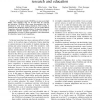AMS
2007
Springer
14 years 6 months ago
2007
Springer
In this paper the design goals for a new, open and modular, four-legged robot platform are described that was developed in reaction to the open call for a standard platform issued ...
ICRA
2007
IEEE
14 years 6 months ago
2007
IEEE
— This paper presents USARSim, an open source high fidelity robot simulator that can be used both for research and education. USARSim offers many characteristics that differenti...
SMC
2007
IEEE
14 years 6 months ago
2007
IEEE
—Conventional models of multirobot control assume independent robots and tasks. This allows an additive model in which the operator controls robots sequentially neglecting each u...
SMC
2007
IEEE
14 years 6 months ago
2007
IEEE
—It is desirable that colony robots be autonomous and self-sufficient, which requires that they can perform their duties while maintaining enough energy to operate. In previous w...
SMC
2007
IEEE
14 years 6 months ago
2007
IEEE
—This paper discusses a new implementation of embodied evolution that uses the concept of punctuated anytime learning to increase the complexity of tasks that the learning system...
ROMAN
2007
IEEE
14 years 6 months ago
2007
IEEE
— For a robot to be able to first understand and then achieve a human’s goals, it must be able to reason about a) the context of the current situation (with respect to which i...
ROMAN
2007
IEEE
14 years 6 months ago
2007
IEEE
Robot Programming by Demonstration (RbD) covers methods by which a robot learns new skills through human guidance. In this work, we take the perspective that the role of the tea...
ROMAN
2007
IEEE
14 years 6 months ago
2007
IEEE
— We suggest that people’s responses to a robot of which attention starts to be distracted show whether they accept the robot as an intentional communication partner or not. Hu...
ROMAN
2007
IEEE
14 years 6 months ago
2007
IEEE
— In this work, we further test the hypothesis that physical embodiment has a measurable effect on performance and impression of social interactions. Support for this hypothesis ...
ROMAN
2007
IEEE
14 years 6 months ago
2007
IEEE
Abstract—In this paper, we present the humanoid communication robot Fritz. Our robot communicates with people in an intuitive, multimodal way. Fritz uses speech, facial expressio...




